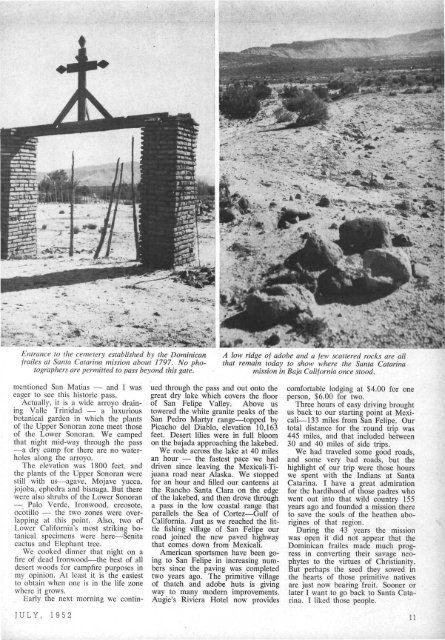desert calendar - Desert Magazine of the Southwest
desert calendar - Desert Magazine of the Southwest
desert calendar - Desert Magazine of the Southwest
Create successful ePaper yourself
Turn your PDF publications into a flip-book with our unique Google optimized e-Paper software.
S»* *",. *"*<br />
Entrance to <strong>the</strong> cemetery established by <strong>the</strong> Dominican<br />
frailes at Santa Catarina mission about 1797. No photographers<br />
are permitted to pass beyond this gate.<br />
mentioned San Matias — and I was<br />
eager to see this historic pass.<br />
Actually, it is a wide arroyo draining<br />
Valle Trinidad — a luxurious<br />
botanical garden in which <strong>the</strong> plants<br />
<strong>of</strong> <strong>the</strong> Upper Sonoran zone meet those<br />
<strong>of</strong> <strong>the</strong> Lower Sonoran. We camped<br />
that night mid-way through <strong>the</strong> pass<br />
—a dry camp for <strong>the</strong>re are no waterholes<br />
along <strong>the</strong> arroyo.<br />
The elevation was 1800 feet, and<br />
<strong>the</strong> plants <strong>of</strong> <strong>the</strong> Upper Sonoran were<br />
still with us—agave, Mojave yucca,<br />
jojoba, ephedra and bisnaga. But <strong>the</strong>re<br />
were also shrubs <strong>of</strong> <strong>the</strong> Lower Sonoran<br />
— Palo Verde, Ironwood, creosote,<br />
ocotillo — <strong>the</strong> two zones were overlapping<br />
at this point. Also, two <strong>of</strong><br />
Lower California's most striking botanical<br />
specimens were here—Senita<br />
cactus and Elephant tree.<br />
We cooked dinner that night on a<br />
fire <strong>of</strong> dead Ironwood—<strong>the</strong> best <strong>of</strong> all<br />
<strong>desert</strong> woods for campfire purposes in<br />
my opinion. At least it is <strong>the</strong> easiest<br />
to obtain when one is in <strong>the</strong> life zone<br />
where it grows.<br />
Early <strong>the</strong> next morning we contin-<br />
ued through <strong>the</strong> pass and out onto <strong>the</strong><br />
great dry lake which covers <strong>the</strong> floor<br />
<strong>of</strong> San Felipe Valley. Above us<br />
towered <strong>the</strong> white granite peaks <strong>of</strong> <strong>the</strong><br />
San Pedro Martyr range—topped by<br />
Picacho del Diablo, elevation 10,163<br />
feet. <strong>Desert</strong> lilies were in full bloom<br />
on <strong>the</strong> bajada approaching <strong>the</strong> lakebed.<br />
We rode across <strong>the</strong> lake at 40 miles<br />
an hour — <strong>the</strong> fastest pace we had<br />
driven since leaving <strong>the</strong> Mexicali-Tijuana<br />
road near Alaska. We stopped<br />
for an hour and filled our canteens at<br />
<strong>the</strong> Rancho Santa Clara on <strong>the</strong> edge<br />
<strong>of</strong> <strong>the</strong> lakebed, and <strong>the</strong>n drove through<br />
a pass in <strong>the</strong> low coastal range that<br />
parallels <strong>the</strong> Sea <strong>of</strong> Cortez—Gulf <strong>of</strong><br />
California. Just as we reached <strong>the</strong> little<br />
fishing village <strong>of</strong> San Felipe our<br />
road joined <strong>the</strong> new paved highway<br />
that comes down from Mexicali.<br />
American sportsmen have been going<br />
to San Felipe in increasing numbers<br />
since <strong>the</strong> paving was completed<br />
two years ago. The primitive village<br />
<strong>of</strong> thatch and adobe huts is giving<br />
way to many modern improvements.<br />
Augie's Riviera Hotel now provides<br />
A low ridge <strong>of</strong> adobe and a few scattered rocks are all<br />
that remain today to show where <strong>the</strong> Santa Catarina<br />
mission in Baja California once stood.<br />
comfortable lodging at $4.00 for one<br />
person, $6.00 for two.<br />
Three hours <strong>of</strong> easy driving brought<br />
us back to our starting point at Mexicali—133<br />
miles from San Felipe. Our<br />
total distance for <strong>the</strong> round trip was<br />
445 miles, and that included between<br />
30 and 40 miles <strong>of</strong> side trips.<br />
We had traveled some good roads,<br />
and some very bad roads, but <strong>the</strong><br />
highlight <strong>of</strong> our trip were those hours<br />
we spent with <strong>the</strong> Indians at Santa<br />
Catarina. I have a great admiration<br />
for <strong>the</strong> hardihood <strong>of</strong> those padres who<br />
went out into that wild country 155<br />
years ago and founded a mission <strong>the</strong>re<br />
to save <strong>the</strong> souls <strong>of</strong> <strong>the</strong> hea<strong>the</strong>n aborigines<br />
<strong>of</strong> that region.<br />
During <strong>the</strong> 43 years <strong>the</strong> mission<br />
was open it did not appear that <strong>the</strong><br />
Dominican frailes made much progress<br />
in converting <strong>the</strong>ir savage neophytes<br />
to <strong>the</strong> virtues <strong>of</strong> Christianity.<br />
But perhaps <strong>the</strong> seed <strong>the</strong>y sowed in<br />
<strong>the</strong> hearts <strong>of</strong> those primitive natives<br />
are just now bearing fruit. Sooner or<br />
later I want to go back to Santa Catarina.<br />
I liked those people.<br />
JULY, 1952 11

















